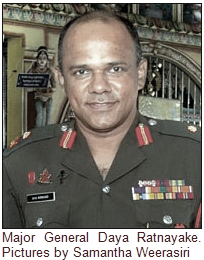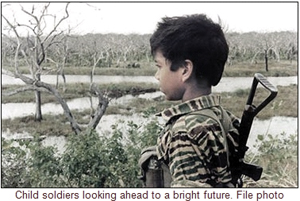
| 29/09/2009 - Daily News | |||
| Gaining peace, the saga of rehabilitation | |||
Just a few years, or even a few months ago they knew only the power of the gun. They were trained to take lives, not respect them. They had heard only of conflict and destruction. The LTTE had brainwashed them into becoming killing machines. With the end of the war, these LTTE cadres have been freed from the shackles of the terrorist organization and have embarked on a journey towards becoming useful citizens. This noble effort is helmed by Major General Daya Ratnayake, who was appointed the Commissioner General of Rehabilitation two months ago. He is in charge of rehabilitating and re-integrating battle hardened ex-LTTE combatants into civil society, a formidable task which the Government has undertaken to carry out with the help of the international community. In an interview with the Daily News, Major General Ratnayake speaks about his challenges. You were involved in an intense battle with the LTTE at one point of time. They were your enemy. Why do you think you were chosen to shoulder this important task of re-integrating the ex-combatants? This is a question you must ask the people who appointed me. We were involved in fighting for the past 30 years. The military aspect of this conflict was only a small portion.
There were a lot of other relative issues, socio-economic, political, humanitarian and civil. Ours was not an ordinary battle fought with guns. In the aftermath of a long dragged conflict, the military officials get invited to shoulder administrative responsibilities. You succeeded to the post of the Commissioner General of Rehabilitation, a post created in 2006 by President Mahinda Rajapaksa. Do you propose to change the methodology adopted in re-integrating these ex-combatants ? We already had a system for rehabilitating ex-cadres since 2006 but the numbers then were much low. There are about 10,000 ex-cadres with us now. This figure is expected to increase to 15,000 with the ongoing screening in the IDP camps to filter out ex-LTTE cadres. This is a sensitive issue. Therefore the Government is anxious to ensure that all the key elements are addressed to evolve a comprehensive re-integrating mechanism. The conflict is over now but we are faced with the physical battle of bridging the gap created during the war. Are we following an indigenous approach or an international model? We have looked at international experience, regional models, and experience gained during the JVP insurgency and designed our own formula for rehabilitation. The next step would be re-integration. We have now worked out a master plan. It has addressed all the key elements. We want to have a homegrown system which suits us the best, touching on religious, cultural, ethical and moral values. These values have been systematically taken away by the LTTE. We have to inculcate these values back in their minds. Is it true you have been given a freehand to perform duties with a lot of powers? Not only a freehand but also a very good concept. The President wants this idea to be put into practice. I receive enormous support from Senior Presidential Advisor Basil Rajapaksa MP and Justice Minister Milinda Moragoda under whose purview I operate. I am happy to work in such an environment. We have produced a National Action Plan and I am keen to get this properly done. Are there any hardcore LTTEers who have committed serious crimes, among these ex-cadres? How do you deal with them? Yes, we have all sorts of cadres who had committed inhuman acts, from novices to hardcore members. Their background has been traced, age, who they are, what their position in the organization, family details, education, skill level and desires and hopes. The profiling has been completed. From the day one of their identification, these facts have been collected. The Army had carried out a great job. Now that the profiling is completed, where would you go from here? Now the proper re-habilitation will commence. The ex-cadres will be separated into groups of 500 each, based on their profiles. They will be exposed to the business community where they can interact and learn about future employment opportunities and availability. Then they will be re-grouped based on different future aspirations. Our target is to set up 20 ‘Protection, Accommodation and Rehabilitation Centres’ to house these ex-cadres. How do you tackle the psychological aspect? There is a comprehensive program. This is one of the main components of the rehabilitation program, psychological and spiritual guidance. How long will they undergo this transformation? We have planned it for five years. But the main process will be for one to two years. Until they become self sufficient, we will look after them. There is a different approach towards child soldiers. International organizations including the UN are working with us. The majority of the detained cadres are between 18 to 35 years. The child conscripts are from 12 to 18. We have one combatant who is 70 years. Could the ex-combatants ever be normal human beings, considering the bitter experience they were exposed to, especially the child soldiers? Definitely, they will be responsible human beings. What is in store for the ex-cadres at the end of their rehab program? Our objective is to find employment for every one of them. Among the detainees, there are about 4,000 skilled persons, the rest are non skilled. Seventy percent of the skilled have a farming background. The training to the ex-cadres will ensure that they could go back to their villages and contribute to national development. We have made arrangements for the child soldiers to pursue school education. Government teachers conduct daily lessons in the welfare centres. A batch of ex-cadres is preparing to sit the GCE O/L examination in December this year. Another group sat the GCE Advanced Level last August. What are the obstacles you have faced up to now? Is there a dearth of psychiatrists? International agencies like the UN have come forward to help us in this challenge. The magnitude of this task is overwhelming and a huge challenge for a country like ours. But we have taken up the task of integrating a disintegrated community. The local community, Tamil Diaspora and especially the business community have shown a great interest in assisting us in this endeavour. There is a role to be played by society as well. They must be ready to accept these people. If it can play an active role our job would be faster and much easier. Would anyone want to recruit an ex-combatant into their ranks? The response from the business community to our program is encouraging and positive. Some large companies especially in the agriculture sector has shown an interest to recruit some of these ex-cadres after they are rehabilitated. The President and the Defence Secretary too are happy with the outcome. Sending ex-cadres for overseas jobs is one of the incentives offered in the re-integration process. Given the fact the LTTE is much strong on the international front, don’t you think sending the ex-cadres overseas for jobs is a risky undertaking? We are confident that once the rehabilitation process is completed these people will not want to be part of the LTTE ever again. The rehabilitation is not about taking these 10,000 to our side. The objective is to make them become responsible citizens. Make sure that they will never ever want to further the cause of terrorism or separatism. |
|||

